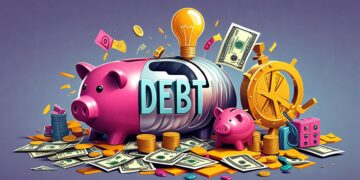How to Use the “Debt Snowball” Technique to Quickly Eliminate Debt

Understanding the Debt Snowball Technique
Managing debt can often feel like navigating through a dense fog, where the path to financial freedom appears obscured. Yet, there are structured approaches that can significantly alleviate this burden. One such method is the Debt Snowball technique, a strategy specifically designed to simplify and expedite the process of debt repayment. By focusing on the smallest obligations first, this method not only reduces the number of debts but also boosts your morale as you witness tangible progress.
How It Works
The Debt Snowball technique hinges on three straightforward steps that prioritize psychological engagement alongside financial strategy:
- List your debts from the smallest amount owed to the largest, ignoring interest rates in this initial phase. This allows you to visually map out your debts and identify quick targets.
- Make minimum payments on all your debts except for the smallest one on your list. This ensures that while you are intensively focusing on one debt, you still maintain your financial obligations elsewhere.
- Put any extra money that you can spare towards the smallest debt until it is completely paid off. This could include bonuses from work, tax refunds, or even a temporary side hustle’s earnings.
Once the smallest debt is settled, you shift that payment towards the next smallest debt, allowing your efforts to accumulate—much like a snowball rolling down a hill, gaining size and speed. The rapid elimination of debts creates a powerful psychological effect, known as the ‘quick win’ phenomenon, that motivates individuals to continue their journey.
The Psychological Edge
Research supports the notion that individuals employing the Debt Snowball method report higher motivation levels throughout their debt repayment journey compared to those who focus solely on interest rates. The prevailing thought is that by focusing on smaller debts first, individuals can tangibly experience a sense of accomplishment, which propels them forward. These victories can shift one’s perspective on debt from a debilitating burden to a conquerable challenge.
Moreover, an illustration of this technique could involve someone with three debts: $500 owed on a credit card, $2,000 for a personal loan, and $10,000 in student loans. By concentrating efforts on the $500 credit card, that debt could be wiped out quickly, providing a motivational boost. With the credit card payment now freed up, the individual can add that amount toward the personal loan, accelerating its repayment as well.
Building Financial Confidence
The Debt Snowball technique not only assists in reducing financial stress, but it also enriches the participant’s understanding of money management. With each debt that gets paid off, individuals learn vital lessons about discipline, budgeting, and resilience. This can lead to better financial habits in the long run, ultimately crafting a more secure financial future.
In conclusion, the Debt Snowball method offers a dynamic and effective strategy to dismantle debt, serving both as a practical approach and as a source of emotional empowerment. Exploring this methodology may just be the key to transforming your financial outlook and regaining control over your finances.
CHECK OUT: Click here to explore more
Steps to Implementing the Debt Snowball Technique
The Debt Snowball technique is not just a theoretical concept; it’s a practical approach that anyone can adopt to take charge of their financial situation. By understanding and implementing the steps outlined below, you can effectively launch your journey towards debt elimination.
Create a Detailed Debt List
The first step in utilizing the Debt Snowball technique is to create a comprehensive list of all your debts. This list should include credit cards, loans, and any other forms of debt arranging them from the smallest balance to the largest. For many, this might seem overwhelming, but knowing precisely what you owe is a critical first step to regaining control. Consider including the following details for each debt:
- Creditor Name: The financial institution or individual to whom you owe money.
- Amount Owed: The total balance remaining on the debt.
- Minimum Payment: The least amount you are required to pay monthly.
- Due Dates: The dates by which you need to make the payments.
This detailed account serves as a roadmap for your financial strategy, allowing you to visualize progress and keep track of your goals. For instance, if you have several credit cards with various outstanding balances, listing them from smallest to largest will help maintain focus as you tackle them one at a time.
Focus Your Payments Wisely
Once your debt list is finalized, it’s time to take action. The principle of the Debt Snowball technique is to channel all your extra money into the smallest debt on your list while making minimum payments on the rest. This concentrated effort builds momentum and leads to quicker payoffs.
Consider this scenario: imagine you have credit card debt of $300, a personal loan for $3,000, and an auto loan of $15,000. If you prioritize the $300 credit card, redirect any additional funds—like a part of your paycheck or money saved from cutting discretionary spending—into paying that off as swiftly as possible. This might mean skipping that coffee shop visit or not dining out for a month. While these sacrifices may seem trivial, they add up quickly!
Celebrate Your Progress
As you begin to pay off your smaller debts, take a moment to celebrate these milestones. Each time you eliminate a debt from your list, recognize that achievement—whether it’s treating yourself to a special outing or enjoying your favorite meal. This reinforcement will not only keep your spirits high but also enhance your commitment to the larger goal of becoming debt-free.
The journey through debt repayment may seem daunting, but by embracing the Debt Snowball technique, you can transform it into a series of manageable successes. Understanding and applying these fundamental steps will allow you to build financial confidence while steadily moving toward a debt-free future.
SEE ALSO: Click here to read another article
Maximizing Your Debt Snowball Effect
Implementing the Debt Snowball technique is just the beginning; maximizing its effectiveness can propel you even faster toward freedom from debt. Understanding additional strategies and adjustments can enhance the momentum of your journey. Below are key enhancements to the basic approach that can help you achieve greater financial stability.
Establish an Emergency Fund
One of the critical yet often overlooked components of financial management is having an emergency fund. Before diving into aggressive debt repayment, consider setting aside a small fund—typically $500 to $1,000—specifically for unexpected expenses. This can prevent new debt from accruing when life throws a curveball, such as a vehicle repair or medical bill, ensuring that you can maintain your payment strategy without missing a beat.
Think of your emergency fund as a financial buffer. The goal is not to derail your Snowball efforts, but rather to provide a safety net that allows you to stay on track without incurring more debt from unforeseen circumstances.
Adjust Your Payment Strategy Regularly
As your financial situation evolves, so can your repayment strategy. A periodic review of your budget and expenses is crucial. You may find opportunities to cut additional costs, such as subscription services or dining out, giving you more funds to apply against your debts.
Additionally, consider applying any unexpected income, like bonuses or tax refunds, directly to your smallest debts. This technique can effectively shorten the payoff timeline and enhance the snowball effect, propelling you toward your financial goals much faster.
Visualize Your Progress
In the world of debt repayment, visualization can be a powerful motivator. Create a visual representation of your debt reduction journey, like a chart or graph, that tracks your payments and shows the decreasing balances of your debts. This can create a tangible sense of accomplishment and motivate you to keep going. Seeing your debts dwindle can provide a psychological boost that significantly contributes to your debt repayment success.
Furthermore, consider using apps designed for debt management. Apps like Mint and EveryDollar allow you to monitor your debts while tracking your overall financial health, giving you immediate feedback on your progress and highlighting areas for potential growth.
Share Your Goals with Others
Accountability is a significant factor in any long-term goal, especially in financial endeavors. Share your debt repayment goals with trusted friends or family members. Their encouragement and support can enhance your motivation to stick to your plan. Plus, discussing your journey can often provide inspiration, as you might discover others in your circle facing similar challenges.
Consider joining online communities or participating in local support groups focused on financial planning and debt management. Engaging with others who are committed to eliminating their debt can introduce you to new strategies, success stories, and potential resources you might not have considered.
Celebrate Larger Milestones
In addition to celebrating smaller goals, it’s vital to recognize larger milestones in your repayment journey. For instance, when you cut your total debt in half or pay off the largest debt on your list, acknowledge that achievement with a rewarding experience. You might take a weekend trip, buy something you’ve been wanting, or simply treat yourself to a spa day. Associating rewards with achievement keeps you motivated and invested in your overall journey toward financial independence.
By enhancing your approach to the Debt Snowball technique with these strategies, you can accelerate your progress and create a sustainable plan for eliminating debt. With dedication and smart financial choices, freedom from debt is not just a distant dream, but an achievable reality.
SEE ALSO: Click here to read another article
Conclusion
The Debt Snowball technique is more than just a method for paying off debt; it embodies a mindset focused on gradual and sustained financial recovery. By starting with your smallest debts and allowing the momentum of your victories to drive your progress, you can achieve significant financial freedom. Remember, the journey to becoming debt-free is as much about the behaviors you foster as it is about the numbers you crunch.
Building an emergency fund, regularly adjusting your strategy, visualizing your progress, and seeking accountability are essential components of this process. Each of these strategies not only enhances the effectiveness of the Debt Snowball method but also helps cultivate a healthier relationship with finances. Additionally, celebrating larger milestones serves to keep your motivation alive; it reminds you that every step you take is a step closer to financial independence.
Ultimately, the power of the Debt Snowball technique lies in its simplicity and effectiveness. By committing to this approach and integrating these enhancements into your financial plan, you turn the daunting challenge of debt repayment into an achievable goal. Consider exploring resources such as financial education books, podcasts, and online communities that can provide further insights and support. The road to financial freedom is within reach, and with determination and the right tools, it can transform from a daunting dream into a triumphant reality. Start today, and watch your debt diminish while your financial future expands.

Linda Carter is a writer and financial expert specializing in personal finance and financial planning. With extensive experience helping individuals achieve financial stability and make informed decisions, Linda shares her knowledge on the Father Company platform. Her goal is to empower readers with practical advice and strategies for financial success.





